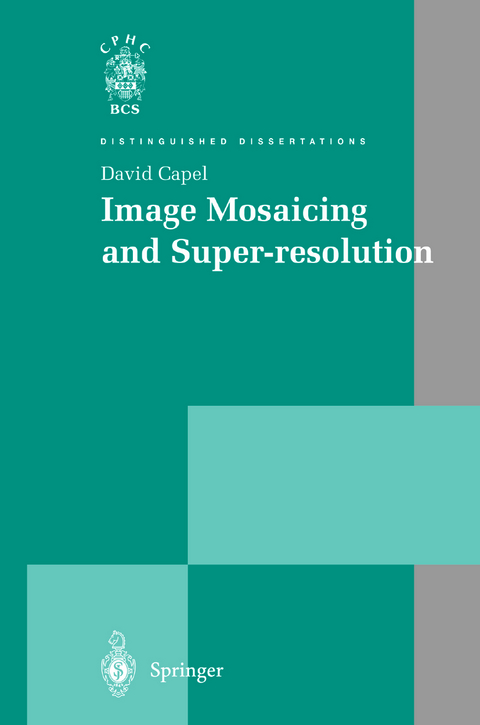
Image Mosaicing and Super-resolution
Springer London Ltd (Verlag)
978-1-4471-1049-1 (ISBN)
This book investigates sets of images consisting of many overlapping viewsofa scene, and how the information contained within them may be combined to produce single images of superior quality. The generic name for such techniques is frame fusion. Using frame fusion, it is possible to extend the fieldof view beyond that ofany single image, to reduce noise, to restore high-frequency content, and even to increase spatial resolution and dynamic range. The aim in this book is to develop efficient, robust and automated frame fusion algorithms which may be applied to real image sequences. An essential step required to enable frame fusion is image registration: computing the point-to-point mapping between images in their overlapping region. This sub problem is considered in detail, and a robust and efficient solution is proposed and its accuracy evaluated. Two forms of frame fusion are then considered: image mosaic ing and super-resolution. Image mosaicing is the alignment of multiple images into a large composition which represents part of a 3D scene. Super-resolution is a more sophisticated technique which aims to restore poor-quality video sequences by mod elling and removing the degradations inherent in the imaging process, such as noise, blur and spatial-sampling. A key element in this book is the assumption of a completely uncalibrated cam era. No prior knowledge of the camera parameters, its motion, optics or photometric characteristics is assumed. The power of the methods is illustrated with many real image sequence examples.
1 Introduction.- 1.1 Background.- 1.2 Modelling assumptions.- 1.3 Applications.- 1.4 Principal contributions.- 2 Literature Survey.- 2.1 Image registration.- 2.2 Image mosaicing.- 2.3 Super-resolution.- 3 Registration: Geometric and Photometric.- 3.1 Introduction.- 3.2 Imaging geometry.- 3.3 Estimating homographies.- 3.4 A practical two-view method.- 3.5 Assessing the accuracy of registration.- 3.6 Feature-based vs. direct methods.- 3.7 Photometric registration.- 3.8 Application: Recovering latent marks in forensic images.- 3.9 Summary.- 4 Image Mosaicing.- 4.1 Introduction.- 4.2 Basic method.- 4.3 Rendering from the mosaic.- 4.4 Simultaneous registration of multiple views.- 4.5 Automating the choice of reprojection frame.- 4.6 Applications of image mosaicing.- 4.7 Mosaicing non-planar surfaces.- 4.8 Mosaicing “user’s guide”.- 4.9 Summary.- 5 Super-resolution: Maximum Likelihood and Related Approaches.- 5.1 Introduction.- 5.2 What do we mean by “resolution”?.- 5.3 Single-image methods.- 5.4 The multi-view imaging model.- 5.5 Justification for the Gaussian PSF.- 5.6 Synthetic test images.- 5.7 The average image.- 5.8 Rudin’s forward-projection method.- 5.9 The maximum-likelihood estimator.- 5.10 Predicting the behaviour of the ML estimator.- 5.11 Sensitivity of the ML estimator to noise sources.- 5.12 Irani and Peleg’s method.- 5.13 Gallery of results.- 5.14 Summary.- 6 Super-resolution Using Bayesian Priors.- 6.1 Introduction.- 6.2 The Bayesian framework.- 6.3 The optimal Wiener filter as a MAP estimator.- 6.4 Generic image priors.- 6.5 Practical optimization.- 6.6 Sensitivity of the MAP estimators to noise sources.- 6.7 Hyper-parameter estimation by cross-validation.- 6.8 Gallery of results.- 6.9 Super-resolution “user’s guide”.- 6.10 Summary.- 7Super-resolution Using Sub-space Models.- 7.1 Introduction.- 7.2 Bound constraints.- 7.3 Learning a face model using PCA.- 7.4 Super-resolution using the PCA model.- 7.5 The behaviour of the face model estimators.- 7.6 Examples using real images.- 7.7 Summary.- 8 Conclusions and Extensions.- 8.1 Summary.- 8.2 Extensions.- 8.3 Final observations.- A Large-scale Linear and Non-linear Optimization.- References.
| Reihe/Serie | Distinguished Dissertations |
|---|---|
| Zusatzinfo | XII, 218 p. |
| Verlagsort | England |
| Sprache | englisch |
| Maße | 152 x 229 mm |
| Themenwelt | Informatik ► Grafik / Design ► Digitale Bildverarbeitung |
| Informatik ► Theorie / Studium ► Künstliche Intelligenz / Robotik | |
| Schlagworte | Image mosicing • Image Registration • Super-resolution |
| ISBN-10 | 1-4471-1049-8 / 1447110498 |
| ISBN-13 | 978-1-4471-1049-1 / 9781447110491 |
| Zustand | Neuware |
| Haben Sie eine Frage zum Produkt? |
aus dem Bereich


